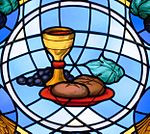
Back Anafora Addaie a Mariho Czech Liturgie von Addai und Mari German Anaphore de Addaï et Mari French Anafora di Addai e Mari Italian Anafora Addaja i Mariego Polish Литургия Фаддея и Мария Russian Літургія Тадея і Марія Ukrainian
| Part of a series on |
| Eastern Christianity |
|---|
 |
| Part of a series on |
| Particular churches sui iuris of the Catholic Church |
|---|
| Particular churches are grouped by liturgical rite |
| Alexandrian Rite |
| Armenian Rite |
| Byzantine Rite |
| East Syriac Rite |
| Latin liturgical rites |
| West Syriac Rite |
|
Eastern Catholic Churches Eastern Catholic liturgy |
| Part of a series on |
| Christianity |
|---|
 |
| Part of a series on the |
| Eucharist |
|---|
 |
The Liturgy of Addai and Mari (or the Holy Qurbana of Mar Addai and Mar Mari) is the Eucharistic liturgy belonging to the East Syriac Rite and was historically used in the Church of the East of the Sasanian (Persian) Empire. This liturgy is traditionally attributed to Saint Addai (disciple of Saint Thomas the Apostle) and Saint Mari (a disciple of Saint Addai). It is currently in regular use in the Assyrian Church of the East (including its archdiocese the Chaldean Syrian Church of India), the Ancient Church of the East, the Syro-Malabar Catholic Church of India, and the Chaldean Catholic Church. The latter two are Eastern Catholic churches in full communion with the Holy See of Rome.
The Anaphora of Addai and Mari is similar to the ancient eucharistic rite of the Didache, belonging to "a primordial era" before the Words of Institution were made standard across other anaphoras.[1] The Anaphora of Addai and Mari is perhaps the only anaphora in continuous use by an apostolic church since its establishment.[2][3] The anaphora that is part of this liturgy is of particular interest, being one of the oldest in Christianity, possibly dating back to 3rd-century Edessa,[4] even if the outline of the current form can only be traced as far back as the time of the Patriarch Ishoyahb III in the 7th century. In the form given in the oldest manuscripts, this anaphora does not include the Words of Institution, which has raised ecumenical concerns. The Eastern Catholic churches employing this liturgy have inserted the Words of Institution in accordance with their Eucharistic teaching.
Relations between Rome and the Assyrian Church have dramatically improved since the 1980s. The patriarch, Mar Dinkha IV, visited Pope John Paul II in Rome in 1984 and participated in a day of prayer for peace at Assisi in 1986. In 1994, Mar Dinkha and Pope John Paul II signed a common declaration in the Vatican.[5] This common Christological declaration between the Catholic Church and the Assyrian Church of the East in 1994 established that both churches confessed the same doctrine concerning Christology (the divinity and humanity of Christ). This declaration went on to create a mixed committee for further theological dialogue between the two (now sister) churches. The text affirmed that Catholics and Assyrians are "united today in the confession of the same faith in the Son of God". In 2001 this committee drew up guidelines for mutual admission to the eucharist between the Chaldean Catholic Church and the Assyrian Church of the East, overcoming the issue of the lack of words of Institution in the Anaphora of Addai and Mari.[6]
- ^ "Sarhad Yawsip Jammo, The Anaphora of Addai and Mari: A Study of Structure and Historical Background". Archived from the original on 1 December 2007. Retrieved 24 June 2021.
- ^ Mateusz Rafal Potoczny (2019) https://www.researchgate.net/publication/337307286_THE_ANAPHORA_OF_THE_APOSTLES_ADDAI_AND_MARI_AND_ITS_CHRISTOLOGICAL_CHARACTER
- ^ Stylianos Muksuris, The Anaphorae of the Liturgy of Sts. Addai and Mari and the Byzantine Liturgy of St. Basil the Great: A Comparative Study.
- ^ Addai and Mari, Liturgy of. Cross, F. L., ed. The Oxford Dictionary of the Christian Church. Oxford University Press. 2005
- ^ "Relations between the Catholic Church and the Assyrian Church of the East". CNEWA.org. Retrieved 23 September 2019.
- ^ "Guidelines for admission to the Eucharist between the Chaldean Church and the Assyrian Church of the East". Vatican.va. Archived from the original on 3 November 2015. Retrieved 26 July 2010.
© MMXXIII Rich X Search. We shall prevail. All rights reserved. Rich X Search